A Celebration of Theatre
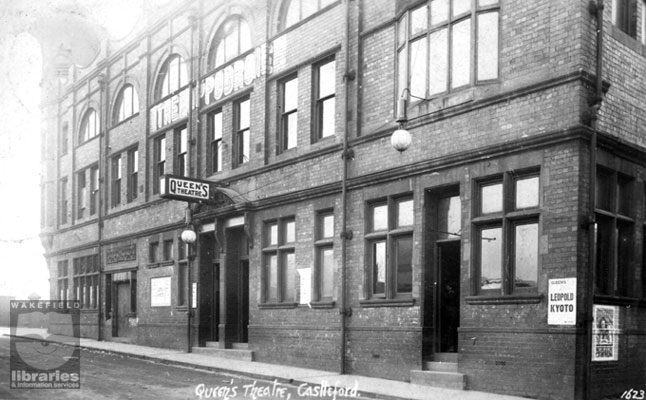
Castleford, Queens Theatre
We begin our tour with one of Castleford’s two professional theatre buildings, the Queens Theatre, which began life as Queens Hall in 1899. It was used for Concerts, Lectures, Demonstration, Balls etc. In 1904 the lease changed, and the building became known as the Hippodrome, and then in 1909 as the Queen’s Theatre. At this time theatrical entertainment was extremely popular with the public and the building was expanded and refitted. The Theatre could seat 1,700, had 5 dressing rooms and a stage measuring 23 x 49 Feet. The advent of moving pictures eventually saw a shift in interest and by the late 1920s the venue again underwent a change and the Queen’s Cinema came into being seating 980 viewers. Sadly in 1959 this also came to an end, although after several changes of use over the years the building continues to serve the public as a Public House and nightclub.
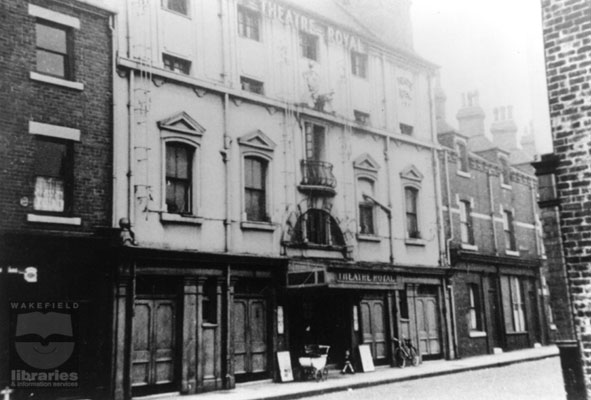
Castleford, Theatre Royal
Castleford’s second theatre, the Theatre Royal can trace no less an eventful history. Initially built as a salvation army barracks in the 1880s, it was converted to a theatre around 1890. It was closed for renovations in 1892, re-opening in the same year, with a seating capacity of 1,500, a 30 x 60 foot stage and 8 dressing rooms for the use of visiting artistes. Though the theatre changed hands by auction in 1919, a series of variety shows, plays and pantomimes continued to take place. February 1938 saw a fire, which destroyed the public bars, but left the auditorium and stage areas undamaged. By January 1955 interest had waned and the theatre closed. The next 5 years saw a number of attempts to revive it including attempts to use it as a wrestling venue and as a theatre/restaurant, but sadly none of these thrived and the building was converted to use as a supermarket.
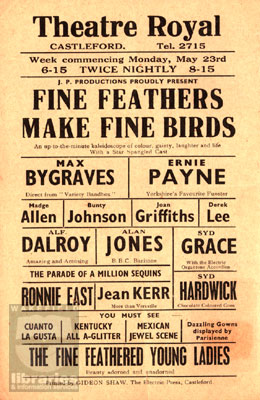
Castleford, Theatre Royal Advertisement
A theatre however is just a building until brought to life by the performers and audience, and this image is an example of just one of the many variety shows that took place at Castleford’s Theatre Royal. The ‘star spangled cast’ of this show included a young Max Bygraves. The show was entitled ‘Fine Feathers Make Fine Birds’ and the programme included comedians, singers and musicians. Many variety performers who appear on Castleford playbills such as this later went on to stardom in the upcoming medias of television and film, including Stan Laurel, Hylda Baker and Roy Castle. These first three examples of theatre in the Wakefield District remind us of the huge changes to the popularity and format of the live theatre medium over the last 150 years especially following the advent of film and television.
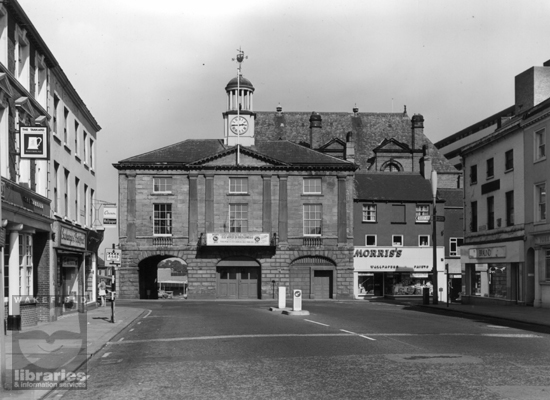
Pontefract, Town Hall
The neighbouring community of Pontefract was entertained by productions not just in purpose built theatres but also at venues including Pontefract Town Hall, which was built in 1785, and the Assembly Rooms adjoining, built in 1881. Having a stage, the Town Hall, shown here, has always been used by many local amateur drama groups, as well as by touring professional companies; in 1864 there was a Marionette Show, whilst in 1869 a concert was held by the Royal Christy’s – the Queen’s Minstrel Band. Pontefract initially had a stone-built theatre, erected in 1788-89, which was situated between Baxtergate and Gillygate, but in 1837 it was sold for use as a School. The Alexandra Theatre, built in 1906, was situated in Tanshelf. It was a 3-storey building and had orchestra stalls, a pit, a dress circle and a gallery. The Alexandra was converted into a cinema in 1935 and demolished in the early 1970s.
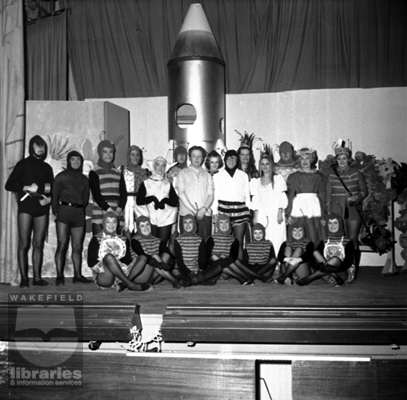
Ossett, Town Hall
In Ossett the Town Hall too was a popular venue for amateur theatre as well as dances and other community social events. In this image local amateur theatre group the Centre Players pose on stage for the children’s fantasy play the ‘Bee People’ from the 1966 play by Allen Cullen, performed in December 1970. The Centre Players were formed in 1964 and had many successful productions until their disbandment in the late 1980s. Amateur theatre continues to take place in Ossett and local theatre society the Priory Players (previously known as the Green Players and the Congregational Players) have been producing plays and pantomimes since 1902. Theatre on our district has appeared in a variety of formats and venues by professionals and amateurs alike, and not just in purpose built theatres, which, as we have seen, changed with the advent of film and television.
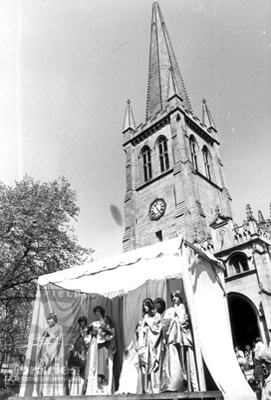
Wakefield Mystery Plays
Wakefield has perhaps the longest established theatre tradition in the District with the ancient Wakefield mystery plays. During the Middle Ages mystery plays, which were dramatisations of Bible stories, were traditionally performed on Corpus Christi Day by members of local craft guilds. The Wakefield mystery plays were known as the Towneley cycle as the manuscript was for many years in the possession of the Towneley family in Lancashire. Interest in the plays, part of a much earlier tradition of local theatre was revived in 20th century, as can be seen from this image. A selection of 12 plays were performed in Wakefield by local dramatic groups as part of the Queen’s Silver Jubilee celebrations in May 1977. Three years later the full cycle of 32 plays was performed in the Cathedral precinct, for the first time for nearly 400 years.
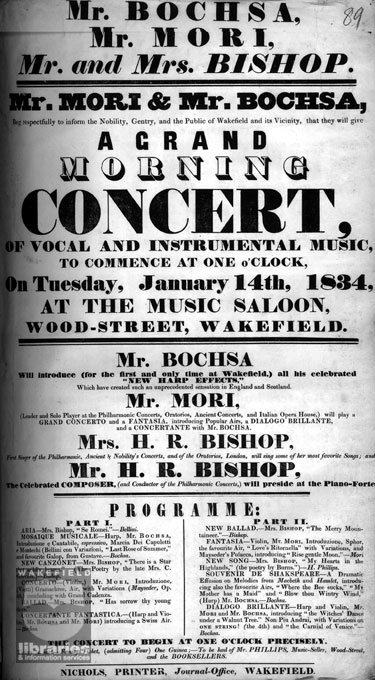
Wakefield, 19th Century Theatre Poster
Wakefield was already a part of a professional repertory and concert circuit in early 19th Century, with many venues playing host to touring companies, artistes and even a circus. This poster advertises a concert of vocal and instrumental music held in the Music Saloon, Wood Street, Wakefield. The Music Saloon was erected in 1820-21 after shares were sold to raise the finance and was run as a commercial venture. The building boasted a large salon on the first floor where the concert probably took place. It was sold at auction in 1855 and became the home of the Mechanics Institute, later to become the City’s museum. The concert featured here on 14th January 1834 included Mr Boscha introducing “harp effects” and Mr Mori on violin. Mrs Bishop sang songs such as “My heart is in the Highlands” and a new ballad by her husband, “The Merry Mountaineer” who also accompanied her on the piano.
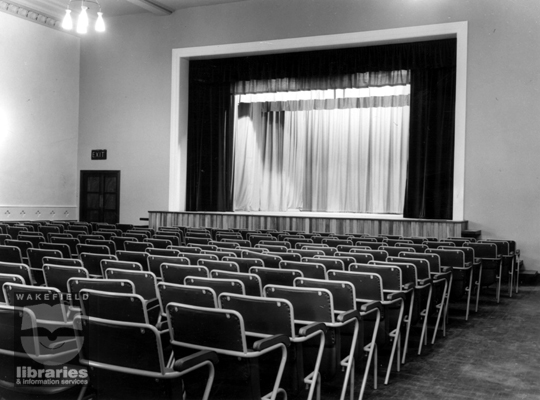
Wakefield, Queen St Theatre
Wakefield had many indoor venues over the years including the Queen Street hall, which was established as late as the mid-20th Century for amateur dramatics. The hall was converted from the old Ebenezer Primitive Methodist chapel, dating from 1838, which had been purchased by Wakefield Council in 1955 and later leased to the Wakefield Little Theatre amateur dramatic group. The theatre could seat 190 and was also used by the group for rehearsals and other events. However Wakefield Council closed the building in 1984. The following year the hall was sold and later converted into a training centre for sporting activities. Wakefield Little Theatre found a new home in the newly-restored Theatre Royal and Opera House.
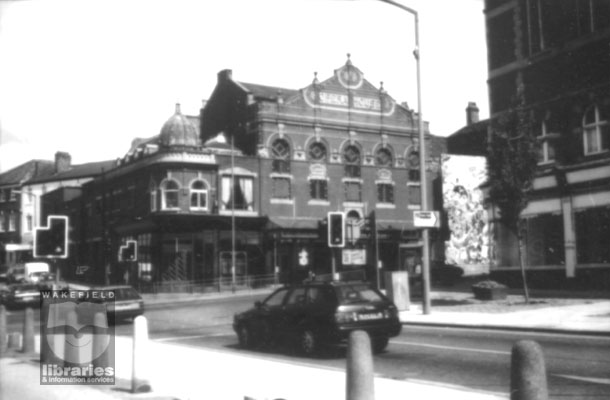
Wakefield, Theatre Royal (Exterior)
Wakefield’s best-known theatre venue today is the Theatre Royal and Opera House, which stands on the corner of Drury Lane and Westgate. Like Castleford’s theatres it has had a chequered history of usage, but unlike them it has been restored to its original purpose. Comparatively small by provincial theatre standards, it was designed by the distinguished theatre architect Frank Matcham in 1894 for Benjamin Sherwood, whose family owned and managed the theatre for over 50 years. The Theatre was sold in 1954 to Essoldo and converted to a cinema in 1954 and as audiences declined, Ladbrokes leased the building and converted it to a Bingo Hall in the late 1960s. After a public meeting was called the Friends of Wakefield Opera House were formed in 1982 and restoration efforts began on the deteriorated fabric of the building.
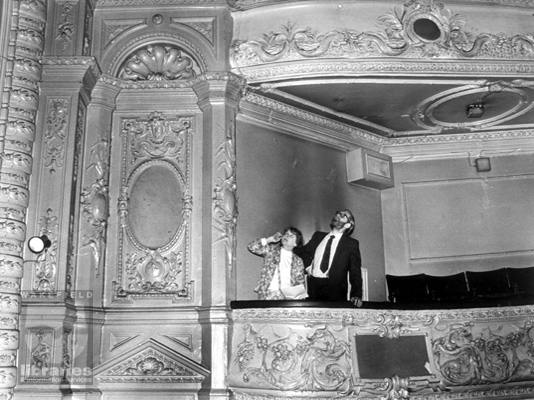
Wakefield, Theatre Royal (Interior)
As this image of Wakefield Theatre Royal and Opera House prior to its 1980s restoration shows, the richly decorated interior was typical of Frank Matcham’s earlier style, characterised by lavishly decorated panels of rococo style plasterwork. The Theatre reopened with a gala evening on the 16th March 1986 and has since hosted a wide variety of touring shows, concerts and has a popular yearly pantomime. Despite the changes of the last century evident in the history of Wakefield District’s purpose built and temporary theatre venues, it is clear that live theatre of all kinds, and revivals of interest, whether in the Mystery Plays, local amateur dramatics and the saving of our theatrical heritage buildings for future generations still has a strong role to play in our local culture.
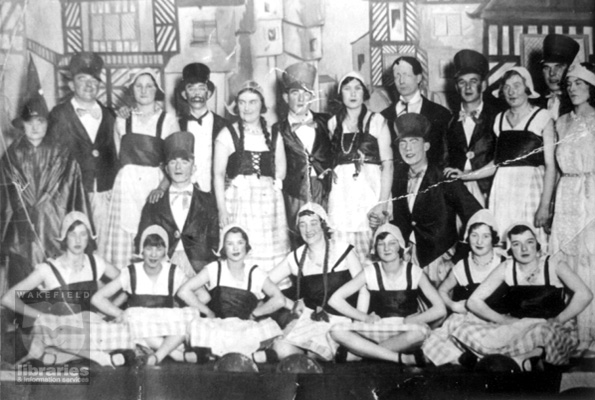
Knottingley, Local Theatrics
Theatre is not just confined to the larger venues, whether purpose built or otherwise, and theatre in our communities still involves a wide variety of school plays, local amateur community groups and church groups whether employed in acting roles, musical accompaniment, stage decoration or costume making. This example shows St Botolph’s Church Drama Group, Knottingley in costume and on stage for a play in the 1920s. The performers are wearing Dutch style costumes, and to the left stands a woman dressed as a witch. Knottingley Town Hall, built in 1865, had a large public room, which served as a local theatre, cinema, exhibition and dance hall, so Theatre has formed an important part of the diverse community life around our district as well as in the larger town and city centres.
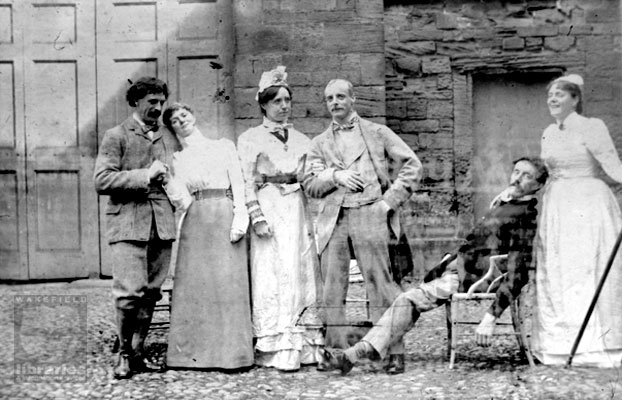
Walton Hall and theatre as Home Entertainment
Finally, theatre can be a form of home entertainment as well as for public performance. This image shows a group of amateur actors from Walton Hall, home of the Waterton family for many years. The actors, possibly house-guests or members of the family are seen here dressed in costumes borrowed from members of household staff. A purpose built private theatre was considered by Charles Winn, the 5th Baronet of Nostell Priory in the 1820s, as a new use for the Riding House on his estate, but was never actually built. Theatre was a popular entertainment in the greatest country houses in the district as well as less grand private homes in pre-television days, and this short trip through some aspects of theatre in the District shows that from the smallest to the largest scale, live performance is an important part of our heritage, despite the popularity of other more recent media such as film and television.

